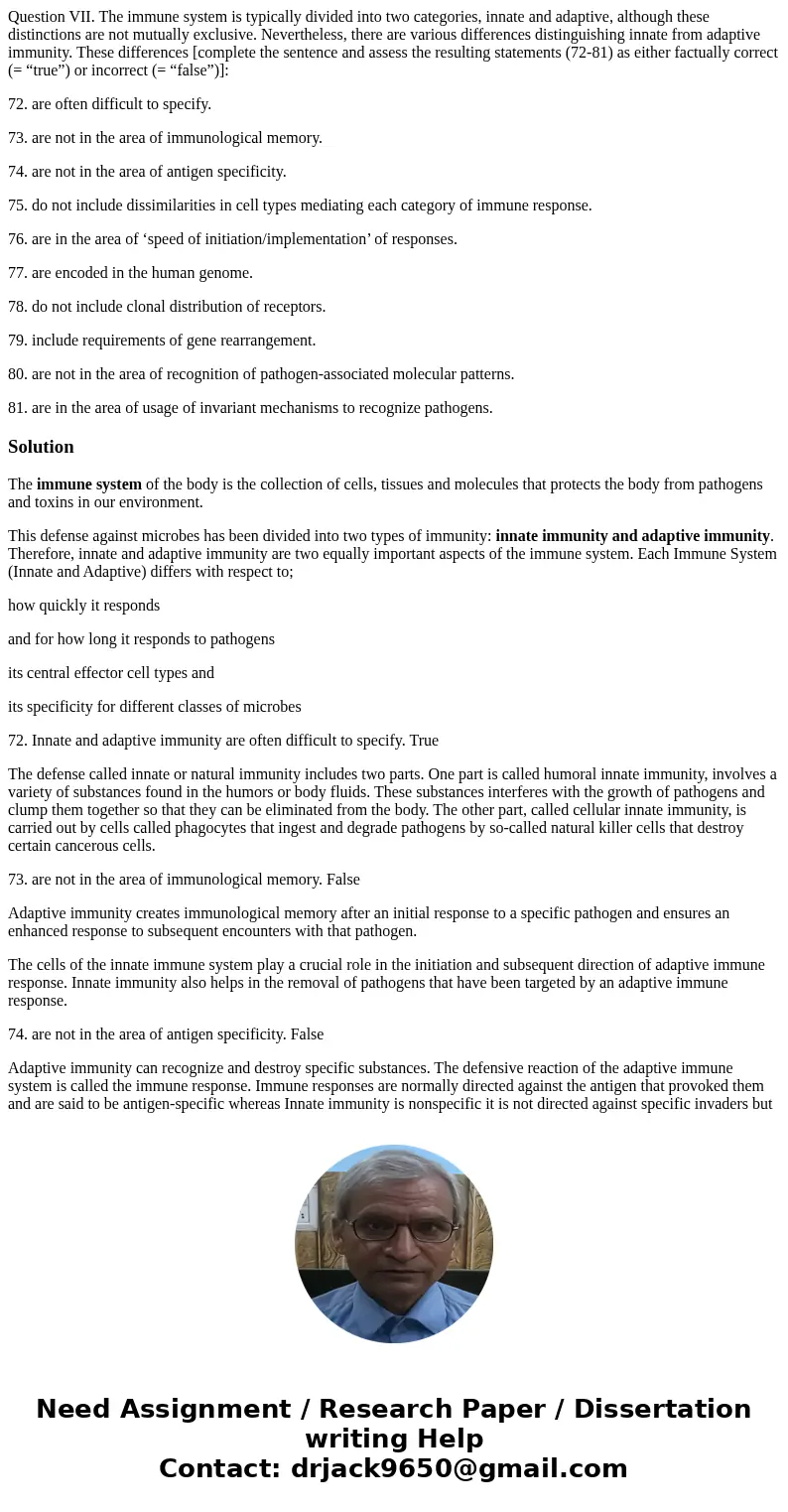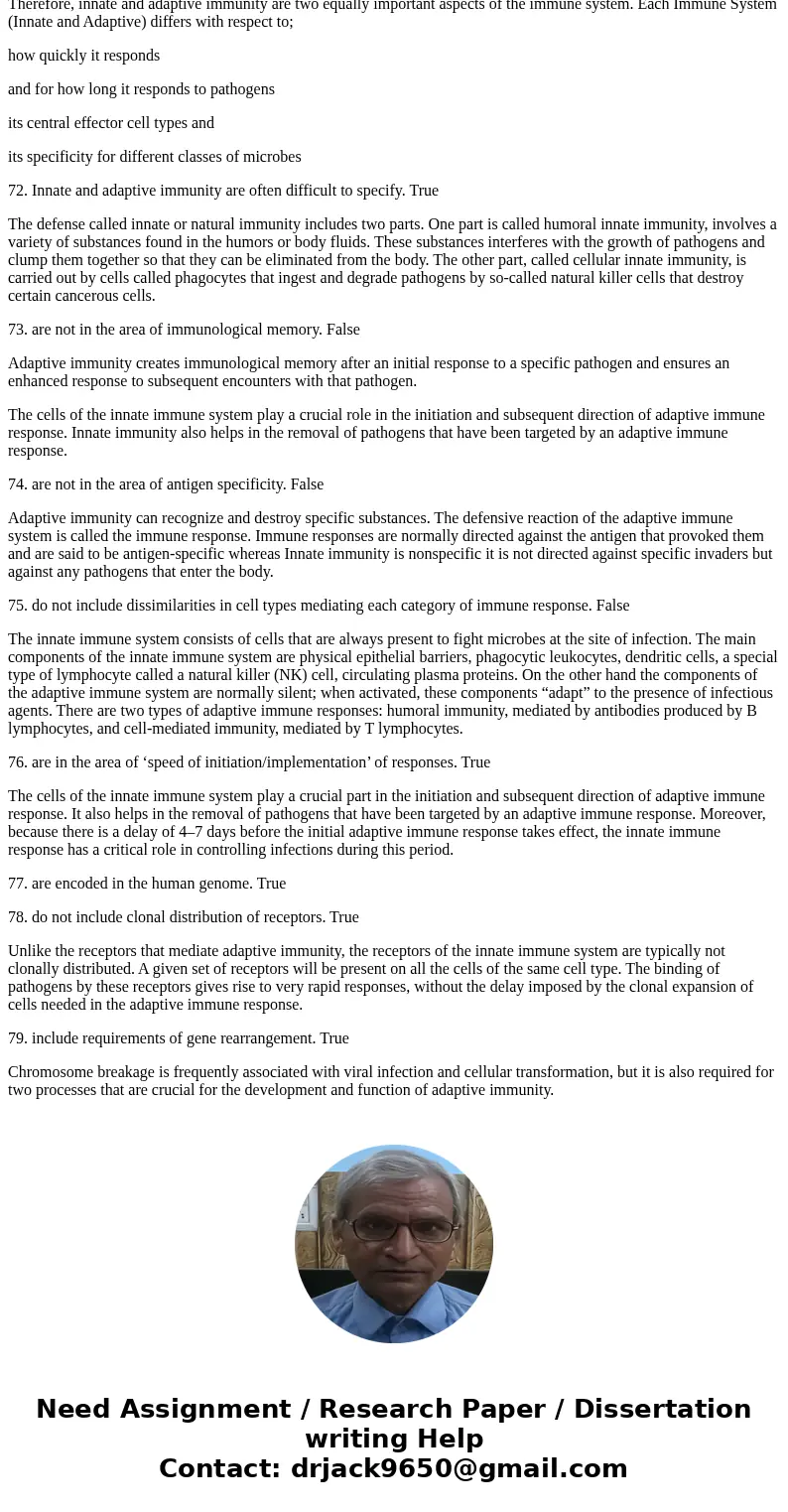Question VII The immune system is typically divided into two
Question VII. The immune system is typically divided into two categories, innate and adaptive, although these distinctions are not mutually exclusive. Nevertheless, there are various differences distinguishing innate from adaptive immunity. These differences [complete the sentence and assess the resulting statements (72-81) as either factually correct (= “true”) or incorrect (= “false”)]:
72. are often difficult to specify.
73. are not in the area of immunological memory.
74. are not in the area of antigen specificity.
75. do not include dissimilarities in cell types mediating each category of immune response.
76. are in the area of ‘speed of initiation/implementation’ of responses.
77. are encoded in the human genome.
78. do not include clonal distribution of receptors.
79. include requirements of gene rearrangement.
80. are not in the area of recognition of pathogen-associated molecular patterns.
81. are in the area of usage of invariant mechanisms to recognize pathogens.
Solution
The immune system of the body is the collection of cells, tissues and molecules that protects the body from pathogens and toxins in our environment.
This defense against microbes has been divided into two types of immunity: innate immunity and adaptive immunity. Therefore, innate and adaptive immunity are two equally important aspects of the immune system. Each Immune System (Innate and Adaptive) differs with respect to;
how quickly it responds
and for how long it responds to pathogens
its central effector cell types and
its specificity for different classes of microbes
72. Innate and adaptive immunity are often difficult to specify. True
The defense called innate or natural immunity includes two parts. One part is called humoral innate immunity, involves a variety of substances found in the humors or body fluids. These substances interferes with the growth of pathogens and clump them together so that they can be eliminated from the body. The other part, called cellular innate immunity, is carried out by cells called phagocytes that ingest and degrade pathogens by so-called natural killer cells that destroy certain cancerous cells.
73. are not in the area of immunological memory. False
Adaptive immunity creates immunological memory after an initial response to a specific pathogen and ensures an enhanced response to subsequent encounters with that pathogen.
The cells of the innate immune system play a crucial role in the initiation and subsequent direction of adaptive immune response. Innate immunity also helps in the removal of pathogens that have been targeted by an adaptive immune response.
74. are not in the area of antigen specificity. False
Adaptive immunity can recognize and destroy specific substances. The defensive reaction of the adaptive immune system is called the immune response. Immune responses are normally directed against the antigen that provoked them and are said to be antigen-specific whereas Innate immunity is nonspecific it is not directed against specific invaders but against any pathogens that enter the body.
75. do not include dissimilarities in cell types mediating each category of immune response. False
The innate immune system consists of cells that are always present to fight microbes at the site of infection. The main components of the innate immune system are physical epithelial barriers, phagocytic leukocytes, dendritic cells, a special type of lymphocyte called a natural killer (NK) cell, circulating plasma proteins. On the other hand the components of the adaptive immune system are normally silent; when activated, these components “adapt” to the presence of infectious agents. There are two types of adaptive immune responses: humoral immunity, mediated by antibodies produced by B lymphocytes, and cell-mediated immunity, mediated by T lymphocytes.
76. are in the area of ‘speed of initiation/implementation’ of responses. True
The cells of the innate immune system play a crucial part in the initiation and subsequent direction of adaptive immune response. It also helps in the removal of pathogens that have been targeted by an adaptive immune response. Moreover, because there is a delay of 4–7 days before the initial adaptive immune response takes effect, the innate immune response has a critical role in controlling infections during this period.
77. are encoded in the human genome. True
78. do not include clonal distribution of receptors. True
Unlike the receptors that mediate adaptive immunity, the receptors of the innate immune system are typically not clonally distributed. A given set of receptors will be present on all the cells of the same cell type. The binding of pathogens by these receptors gives rise to very rapid responses, without the delay imposed by the clonal expansion of cells needed in the adaptive immune response.
79. include requirements of gene rearrangement. True
Chromosome breakage is frequently associated with viral infection and cellular transformation, but it is also required for two processes that are crucial for the development and function of adaptive immunity.


 Homework Sourse
Homework Sourse